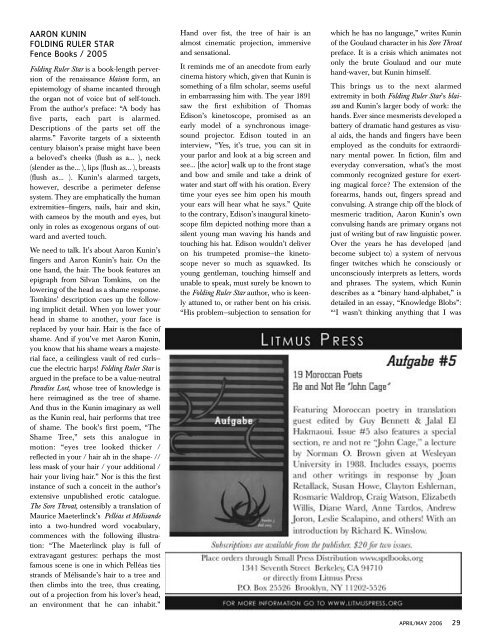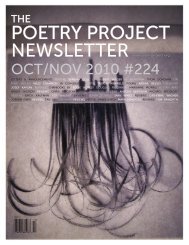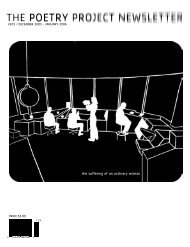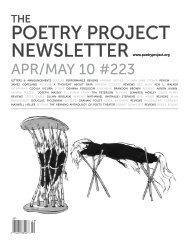elic of her victim spawn. Totemic powersfrom her clan heave the transitionalobject forward and back. That Szymaszekis trafficking in transitional objectsbecomes more evident in “contents / of asecret / bottomed / drawer / yellowed /song / lyrics / wax / phallus / mendingkit.”Belonging to the age of Pisces is the psychicspace of Christian belief that containsthe fishy healing complex wherein asacred relic meets a “Polish sailor.” ForSzymaszek the weight of spirit is packedwith specific ethnicity.<strong>The</strong> lineage of Herman Melville andCharles Olson, which measures theAmerican power to make space fromsemiotic and symbolic capital is extendedin Emptied of All Ship. From Gilgamesh toMaximus, from Homer to Susan Howe,Szymaszek’s ships carry epic orders of relevance.Like Olson, Szymaszek takes onthe imperial historical horizon throughthe mythological expansion of the self.Where Szymaszek differs from Olson is inher desire, which mines Susan Howe, todissolve logistical residue and masculinemarkers that score this horizon.Szymaszek has written the book of aTiamet who eats ships rather than children.In another register, Szymaszek’s“water” advances a hermeneutic moisteningof “<strong>The</strong> Waste Land.” Appropriatelyenough, an erotic, sacrificial line asserts asense of both sacral kingship and matingwith the poet-goddess. For example,“some mariners” expresses the act of unionin Scorpionic waters of sexuality: “Youare a sea monster / I am your sea”(60).<strong>The</strong> book’s title portends a clearing ofanthropocentric cargo yoked to Greekhumanism by Aquarian Grrrl Power.Through no fault of her own Szymaszek’sperception remains bound by time toPiscean vapors. This matter of fate isnailed brilliantly in the telling image thatconcludes the book: “night watcher / withbartered needle / inks the backs of hishands / in Greek” (87). All along the way,Emptied of All Ship stays true to archetypalcomplex that binds Szymaszek’s energy tospace. Ultimately, navigation in “backward/ body” cannot escape Neptune’s ink.Kenneth Warren is the Director of LakewoodPublic Library in Lakewood, Ohio. With FredWhitehead, he edited and introduced <strong>The</strong>Whole Song: Selected Poems by VincentFerrini for University of Illinois Press.REED BYEJOIN THE PLANETS:NEW AND SELECTED POEMSUnited Artists Books / 2005What a wonderful gift to have in hand thistour de forcefield of Reed Bye’s graciousand generous poetic practice! Even longtimefans will be surprised and delightedat the substantial range this new volumepresents. Over one hundred new poemsjoin those carefully selected from hismany books including Some Magic at theDump, Erstwhile Charms, Heart’s Bestiary,Gaspar Still In His Cage, Begin to be Gone,Of Transparency and Passing Freaks andGraces. His range extends from cartoonishwestern ballads to the playfully surrealBony-Handed: a verse play in three scenes, inwhich characters like “It-ball,” “A lowereddowager,” “Barette,” and “He-man”cavort to “undulating organ music” in“Oak groves.”Gerard Manley Hopkins writes, “For itseems to me that the poetical language ofan age should be the current languageheightened, to any degree heightenedand unlike itself, but not (I mean normally:passing freaks and graces are anotherthing) an obsolete one.” Reed Bye doesboth: taking on how a poet can floatthrough as well as dwell in the world,recording, absorbing and reconstitutingreality in language that show new ways ofseeing and being human. Caught wordsand phrases are deftly rewoven intopoems that are somehow simultaneouslyplayful and deeply engaged with the fabricof reality, impermanence and change.<strong>The</strong> book begins with the sparkly andspecific abstract lyric, “Blessing” and endswith the cosmological and philosophical“What I’ve Learned” (Past circumstanceand past all / negotiation / there is space/ and there is / gravity / A single mote ofdust / catches the light…”). <strong>The</strong> poemscreate an “acoustic camera” which transferslucid, multisensory observations aswell as the inner life with which they resonate:“—from one / scooped dewdrop /in the popular life can be / raised theacoustic camera.”In the book’s title poem, Bye reminds usto “Come: / things aren’t exactly / howyou learned them.” His words are sculptedand couched in stanzas that manifestlessons learned from romantics to renga.He is at once a suturing collagist consciousof process, a meditator on the relationof life and art, and a walker in thesun. Many times I am reminded of a sublimelyfresh morning workshop I took ofReed’s in which we went out in search ofhaiku by the stream. “Inside lightly jasmine/ a sword dove with / spookingblows.” Refreshment hits in waves as Iwake up again into each poem – replacinga sepia-toned vision of the world with itsfull-color actuality. Reed Bye’s lifelongpoetic practice melds immediacy with anexpansive openness born from the clarityof real ear, heart, hand.Lee Ann Brown is the author of Polyverse,<strong>The</strong> Sleep That Changed Everything andNascent Toolbox, a collaboration withLaynie Browne.28 APRIL/MAY 2006
AARON KUNINFOLDING RULER STARFence Books / 2005Folding Ruler Star is a book-length perversionof the renaissance blaison form, anepistemology of shame incanted throughthe organ not of voice but of self-touch.From the author’s preface: “A body hasfive parts, each part is alarmed.Descriptions of the parts set off thealarms.” Favorite targets of a sixteenthcentury blaison’s praise might have beena beloved’s cheeks (flush as a... ), neck(slender as the... ), lips (flush as... ), breasts(flush as... ). Kunin’s alarmed targets,however, describe a perimeter defensesystem. <strong>The</strong>y are emphatically the humanextremities—fingers, nails, hair and skin,with cameos by the mouth and eyes, butonly in roles as exogenous organs of outwardand averted touch.We need to talk. It’s about Aaron Kunin’sfingers and Aaron Kunin’s hair. On theone hand, the hair. <strong>The</strong> book features anepigraph from Silvan Tomkins, on thelowering of the head as a shame response.Tomkins’ description cues up the followingimplicit detail. When you lower yourhead in shame to another, your face isreplaced by your hair. Hair is the face ofshame. And if you’ve met Aaron Kunin,you know that his shame wears a majesterialface, a ceilingless vault of red curls—cue the electric harps! Folding Ruler Star isargued in the preface to be a value-neutralParadise Lost, whose tree of knowledge ishere reimagined as the tree of shame.And thus in the Kunin imaginary as wellas the Kunin real, hair performs that treeof shame. <strong>The</strong> book’s first poem, “<strong>The</strong>Shame Tree,” sets this analogue inmotion: “eyes tree looked thicker /reflected in your / hair ah in the shape- //less mask of your hair / your additional /hair your living hair.” Nor is this the firstinstance of such a conceit in the author’sextensive unpublished erotic catalogue.<strong>The</strong> Sore Throat, ostensibly a translation ofMaurice Maeterlinck’s Pelléas et Mélisandeinto a two-hundred word vocabulary,commences with the following illustration:“<strong>The</strong> Maeterlinck play is full ofextravagant gestures: perhaps the mostfamous scene is one in which Pelléas tiesstrands of Mélisande’s hair to a tree andthen climbs into the tree, thus creating,out of a projection from his lover’s head,an environment that he can inhabit.”Hand over fist, the tree of hair is analmost cinematic projection, immersiveand sensational.It reminds me of an anecdote from earlycinema history which, given that Kunin issomething of a film scholar, seems usefulin embarrassing him with. <strong>The</strong> year 1891saw the first exhibition of ThomasEdison’s kinetoscope, promised as anearly model of a synchronous imagesoundprojector. Edison touted in aninterview, “Yes, it’s true, you can sit inyour parlor and look at a big screen andsee... [the actor] walk up to the front stageand bow and smile and take a drink ofwater and start off with his oration. Everytime your eyes see him open his mouthyour ears will hear what he says.” Quiteto the contrary, Edison’s inaugural kinetoscopefilm depicted nothing more than asilent young man waving his hands andtouching his hat. Edison wouldn’t deliveron his trumpeted promise—the kinetoscopenever so much as squawked. Itsyoung gentleman, touching himself andunable to speak, must surely be known tothe Folding Ruler Star author, who is keenlyattuned to, or rather bent on his crisis.“His problem—subjection to sensation forwhich he has no language,” writes Kuninof the Goulaud character in his Sore Throatpreface. It is a crisis which animates notonly the brute Goulaud and our mutehand-waver, but Kunin himself.This brings us to the next alarmedextremity in both Folding Ruler Star’s blaisonand Kunin’s larger body of work: thehands. Ever since mesmerists developed abattery of dramatic hand gestures as visualaids, the hands and fingers have beenemployed as the conduits for extraordinarymental power. In fiction, film andeveryday conversation, what’s the mostcommonly recognized gesture for exertingmagical force? <strong>The</strong> extension of theforearms, hands out, fingers spread andconvulsing. A strange chip off the block ofmesmeric tradition, Aaron Kunin’s ownconvulsing hands are primary organs notjust of writing but of raw linguistic power.Over the years he has developed (andbecome subject to) a system of nervousfinger twitches which he consciously orunconsciously interprets as letters, wordsand phrases. <strong>The</strong> system, which Kunindescribes as a “binary hand-alphabet,” isdetailed in an essay, “Knowledge Blobs”:“‘I wasn’t thinking anything that I wasAPRIL/MAY 2006 29
















